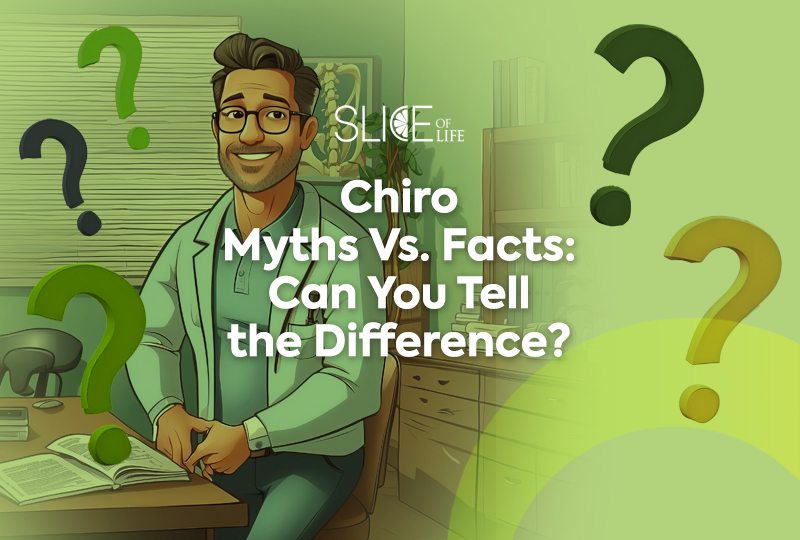There is a lot of misinformation and confused knowledge floating around the internet ether when it comes to Chiropractic. Do you have a good sense of what’s true and what’s not? Let’s test it out!
Chiro Myths Vs. Facts Quiz
(adapted from The Foundation for Chiropractic Progress’ article, “Chiropractic Myths Vs. Facts”)
True or False?
For the best back support, sleeping on your back is best.
Answer: It depends! Proper sleep posture is certainly important, and sleeping on your back can be an excellently supportive sleep position. However, it is more important to make sure your body is supported in whatever sleep position you chose. Your spine should be in alignment. Watch out for awkward leg positions that can create a spine twist. Side sleep can be beneficial, as it lets the spine rest in a natural curve and can relieve heartburn and indigestion. Sleeping on the right side can actually help those with apnea, encouraging blood flow and reducing snoring.
Sleeping on the stomach should be avoided for those with lower back pain or neck pain. For more information on good sleep posture, refer to our previous article on the topic.
True or False?
Stop cracking your knuckles because it will cause arthritis.
Answer: There is not any direct evidence pointing to knuckle cracking causing arthritis. The sound your knuckles make is from the movement of gas bubbles in the fluid of the joints. But just because it doesn’t cause arthritis doesn’t mean that it is a healthy habit. Knuckle-cracking on the regular can lead to reduced grip strength so it is best to leave those hands alone.
True or False?
Flat shoes are the best choice for helping with foot pain.
Answer: Leave the stilettos at home, but your Converse kicks are not the safe bet one might expect. For best spinal alignment, a one-inch heel height is recommended.
For economic reasons, most people make do with pre-made insoles or whatever support is already built into their shoe, but custom orthotics created to match your feet are recommended. Custom orthotics are designed to aid a balanced foundation and stable pelvis. Find custom orthotics that support all three foot arches.
True or False? Stand-up desks make you healthier.
Answer: You might want to sit down for this one, because it’s false. Overuse of the trendy stand-up desk could become a factor in spinal curvature, back pain and unsightly varicose veins. Standing in one place all day long is hard on joints and bones, so a sit-stand desk enables you to alternate your work position as needed and in regular intervals. The screen should be in a position where eyes look directly forward, not up or down. Read more about it in our previous piece.
True or False?
Replacing your chair with a yoga ball will burn calories and make your posture better.
Answer: Don’t count on it. Stores couldn’t hardly keep the colorful orbs on the shelves during the pandemic, whether for general exercise or office use. Verywell Fit goes into more detail about the drawbacks of this practice in their article “Should You Use an Exercise Ball as a Chair?”
The desired core activation and calorie burn are minimal compared to the chance for increased pain and injury risk. There are alternatives on the market that would be a better choice, such as a sit-stand desk, treadmill desk, desk cycle or active sitting cushion.
True or False?
For healing low back pain, a long rest is a good idea.
Answer: Some rest in the short term can help at the first twinge of low back pain, but research suggests that laying around for too long can impede blood flow to the injured area. This in turn can create muscle weakness, stiffness and instability. A Doctor of Chiropractic can recommend stretches and exercise that will help you heal faster, as well as adjustments when appropriate to address the underlying cause or subluxation.
References from original F4CP article
- Study: The Relationship between Sleeping Position and Sleep Quality: A Flexible Sensor-Based Study; Aug. 2022
- Study: Knuckle cracking: Annoying and harmful, or just annoying?; October 27, 2020
- Study: Effects of high-heeled shoes on lower extremity biomechanics and balance in females; April 2023
- Study: Effects of a Workplace Sit–Stand Desk Intervention on Health and Productivity; Nov. 2021
- Study: Unstable Sitting in the Workplace—Are There Physical Activity Benefits? March 2015
- Study: What do the general public believe about the causes, prognosis and best managementstrategies for low back pain? A cross-sectional study; April 2021


Social Media